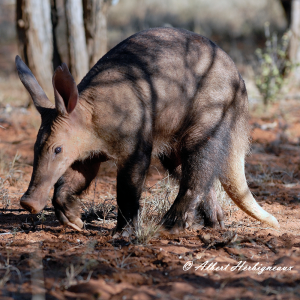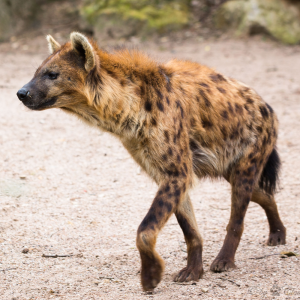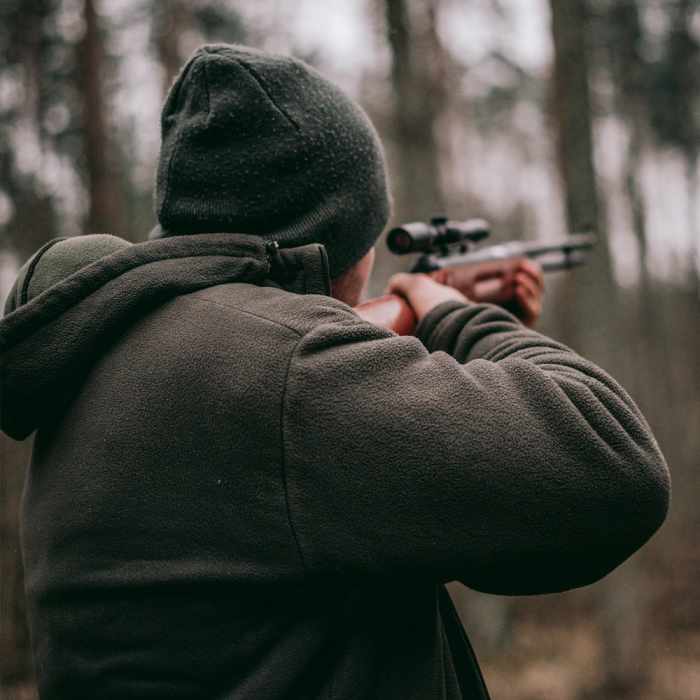PHYSIOLOGY | IMAGES | ETYMOLOGY | TAXONOMY | GEOGRAPHY | BEHAVIOR | DIET | REPRODUCTION | ECOLOGY | CONSERVATION | FAUNAFACTS | VIDEO | SOURCES

The crested porcupine is an Old World porcupine inhabiting Italy, North Africa, and sub-Saharan Africa named for its impressive and defensive crest of 35 centimeter-long quills. Mostly herbivorous, this rodent forages long distances in search of food and lives and breeds in underground burrows in monogamy.
Physiology
The crested porcupine is one of the largest rodents in the world and is considered the largest porcupine. The average adult head and body length of the crested porcupine is 60-93 centimeters (24-37 inches), discounting the tail. Crested porcupines weigh 10-30 kilograms or 22-66 pounds.
The crested porcupine’s skull morphology is characteristic in several ways. The crested porcupine’s infraorbital foramen is greatly enlarged so that portions of the masseter extend through it and arise from the frontal side surface of the animal’s snout, resulting in a hystricomorphous condition. The porcupine’s angular process is inflected on the lower jaw and the animal’s nasal cavity is enlarged. Prominent pocket-like inflations are prominent in the skull, upper jaw, and lacrimal and turbinate bones. The reasons for such pockets are unknown, however they do create enlarged areas of attachment for chewing muscles and could possibly allow the animal to smell underground bulbs during dry periods or wet dry inhaled air.
The crested porcupine has five teeth in each jaw. One incisor, one premolar, and three molars are present in each quadrant. Crested porcupines have high crowned teeth with plane chewing surfaces for grinding plant cells that are then digested in the stomach. Undigested fibers are retained in the enlarged appendix and anterior large intestine and broken down by microorganisms.
The crested porcupine’s ears are external and both the eyes and ears are very small with long vibrissae on its head.
The crested porcupine’s shin and calf bones are fused and the collar bone is greatly reduced.
The forefoot of the crested porcupine has four well-developed, clawed digits while the thumb is regressed. The hind feet have five digits each. The soles of the crested porcupine’s paws are naked and have padded soles, and the porcupine’s gait is plantigrade.
The male’s penis is directed caudally when not erect.
Almost the entire body is covered with bristles which are either dark brown or black and rather coarse. This mammal is recognizable by the quills that run along the head, nape, and back that can be raised into a crest, hence the name crested porcupine. Also, some sturdier quills which are about 35 centimeters (14 inches) in length run along the sides and back half of the body. These sturdier quills are not firmly attached and are used, for the most part, for defense. They are usually marked with light and dark bands which alternate.
The crested porcupine has a shorter tail which has rattle quills at the end. The tail has a length of 8-17 centimeters (3-7 inches). The rattle quills broaden at the terminal end and the broad portion is hollow with thin walls. When these quills are vibrated, they produce a hiss-like rattle.

SEXUAL DIMORPHISM
Larger FemalesBODY LENGTH
60-93 cm. / 24-37 in.TAIL LENGTH
8-17 cm. / 3-7 in.QUILL LENGTH
35 cm. / 14 in.BODY MASS
10-30 kg. / 22-66 lb.DENTAL FORMULA
I ¹⁄1, C ⁰⁄0, P ¹⁄1, M ³⁄3, ×2 = 20LIFESPAN
7-28 yr.GENERATION LENGTH
7 yr.LOCOMOTION
Plantigrade

Images
Taxonomy
The crested porcupine is a species of rodent in the family Hystricidae and the genus Hystrix. Hystrix is a genus of eight species of porcupines containing most of the Old World porcupines, only two of which are found outside of Asia. Fossils belonging to the genus date back to the late Miocene of Africa. Hystrix was given the name by the late 18th century Swedish botanist, Carl Linnaeus. The Hystrix genus includes three subgenera, Thecurus, containing the thick-spined porcupine (Hystrix crassispinis), the Philippine porcupine (Hystrix pumila), and the Sumatran porcupine (Hystrix sumatrae); Acanthion, containing the Malayan porcupine (Hystrix brachyura) and the Sunda porcupine (Hystrix javanica); and Hystrix, including the Cape porcupine (Hystrix africaeaustralis), the Indian crested porcupine (Hystrix indica), and the crested porcupine..
The crested porcupine is distinct among Old World porcupines due to its shorter tail, averaging 8-17 centimeters or 3-7 inches, and the presence of rattle quills at the end of the tail. These quills broaden at the terminal end and this section is hollow and thin-walled. When these quills are vibrated, they produce a hiss-like rattle.
KINGDOM
AnimaliaPHYLUM
ChordataCLASS
MammaliaORDER
RodentiaFAMILY
HystricidaeGENUS
HystrixSPECIES
cristatusSUBSPECIES
None
Etymology
The crested porcupine’s common name refers to the quills along the head, nape, and back that can be raised into a crest, in addition to sturdier quills about 35 centimeters, or 14 inches, long along the sides and back half of the body generally used for defensive purposes. These stronger quills are generally marked with alternating light and dark bands and are not firmly attached. The head, neck, shoulders, limbs and underside of the crested porcupine’s body are covered with dark brown or black bristles that are rather coarse. There are long vibrissae on the head.
The crested porcupine is also known as the North African crested porcupine.
The crested porcupine’s scientific name is Hystrix cristata. The specific name, cristatus, comes from Latin and means provided with a comb, relating to its crest of quills.
ALTERNATE
North African Crested PorcupineGROUP
PrickleMALE
BoarFEMALE
SowYOUNG
Foal, Porcupette, Pup
Region
The crested porcupine is found in Italy, North Africa, and sub-Saharan Africa. In the Mediterranean, it is known from mainland Italy and the islands of Sicily, Morocco, Algeria, and Tunisia. There are also records in Ghana and Libya and along the Egyptian coast. It can be found along the Mediterranean coast of Africa to northern Zaire and Tanzania.
The crested porcupine is extant in Algeria, Angola, Benin, Burkina Faso, Cameroon, Chad, Côte d’Ivoire, Eritrea, Ethiopia, Gambia, Ghana, Guinea-Bissau, Italy, Kenya, Liberia, Libya, Mali, Mauritania, Morocco, Niger, Nigeria, Rwanda, Senegal, Sierra Leone, Somalia, Sudan, Tanzania, Togo, Tunisia, Uganda. It is possibly extinct in Egypt and its presence is unknown in the Central African Republic and in the Congo.
The crested porcupine has been recorded from sea level to 2,550 meters (8,370 feet) in Moroccan Anti Atlas.
Some scientists assert that the porcupine was introduced to Italy by the Romans as a game animal, but fossil and subfossil remains suggest it was possibly present in Europe in the Upper Pleistocene.
The crested porcupine has been extinct in heavily-settled parts of Uganda since the 1970’s and is believed to have recently gone extinct in the Balkans. It may have been extirpated in Egypt since 1980.
EXTANT
Algeria, Angola, Benin, Burkina Faso, Cameroon, Chad, Côte d’Ivoire, Eritrea, Ethiopia, Gambia, Ghana, Guinea-Bissau, Italy, Kenya, Liberia, Libya, Mali, Mauritania, Morocco, Niger, Nigeria, Rwanda, Senegal, Sierra Leone, Somalia, Sudan, Tanzania, Togo, Tunisia, UgandaPOSSIBLY EXTINCT
EgyptUNCERTAIN
Central African Republic, Congo
Habitat
The crested porcupine is highly adaptable and can be found in forest, savanna, shrubland, grassland, rocky, and artificial terrestrial habitats.
They shelter in caves, rock crevices, aardvark holes, or burrows they dig themselves.
In the Mediterranean, it inhabits dry Mediterranean shrubland, maquis, abandoned farmland, steppe, forest, and dry rocky areas.
In West Africa, it is found in both woodland savanna and forest formations. They can also be found in mountains, croplands, and sandhill deserts.
FOREST
Subtropical/Tropical DrySAVANNA
DrySHRUBLAND
Subtropical/Tropical Dry, Mediterranean-Type Shrubby VegetationGRASSLAND
Subtropiocal/Tropical DryROCKY AREAS
Inland Cliffs, Mountain PeaksARTIFICIAL/TERRESTRIAL
Arable Land, Pastureland
Co-Habitants

Aardvark 
Lion 
Leopard 
Spotted Hyaena 
Striped Hyaena
Behavior
Crested porcupines are terrestrial, rarely climbing trees. They are, however, able to swim. The crested porcupine lives and breeds in deep burrows and dens. They shelter in caves, rock crevices, aardvark holes, or burrows that they dig themselves. Burrows are often extensive and used for many years. Individual crested porcupines may remain in burrows through winter but they don’t truly hibernate.
The crested porcupine is a strictly nocturnal animal and has very small eyes and external ears. Moonlight avoidance is slight and only occurs in open areas, unlike in the Indian crested porcupine (Hystrix indica), in which significant moonlight avoidance has been documented.
Crested porcupines may wander upon the skeletons of many animals at night. They have been known to collect thousands of these bones and store them in underground chambers or caves. Sometimes, humans may dig up these bones.
The social life of the crested porcupine is based on monogamy and long, intensive care of the young. Small family groups, consisting of an adult pair and various infants and juveniles, share an elaborate burrow system, though females will establish a separate, grass-lined den within the burrow system to give birth.
The quills of crested porcupines serve as an effective defense against predation. When disturbed, they raise and fan the quills to create an illusion of greater size. If the disturbance continues, they stamp their feet, whirr their quills and charge the enemy, back end first, attempting to stab with the thicker, shorter, sturdier quills. Such attacks have been known to kill lions, leopard, hyenas, and even humans.
CIRCADIAN RHYTHM
NocturnalMOVEMENT PATTERN
Non-Migrant
Diet
The crested porcupine is primarily a herbivorous forager.
Its diet consists of underground bulbs, roots, leaves, tubers, cultivated crops, bark, rhizomes, and fallen fruit. The crested porcupine also occasionally consumes insects, small vertebrates, and carrion. In addition, the porcupine commonly gnaws on bones for calcium and to sharpen incisors.
PREFERENCE
GeneralistSTYLE
Forager
Reproduction
Much of our knowledge of crested porcupine breeding behavior comes from captive individuals.
Breeding occurs throughout the year at the London Zoo, from July to December in Central Africa, and from March to December in Indian zoos. Captive females in South Africa produce litters throughout the year, mainly from August to March with a peak in January.
Mating occurs only at night, both in and out of the burrow. Females do not show aggression to familiar males, but are aggressive to unknowns. Given their spiny anatomy, mating would be impossible without such an adaptation. To mate, the female raises her tail and the male stands on his hind legs, supporting himself with his forefeet on the female’s back. No male weight is transferred to the female, no penile lock occurs, and there are multiple intromissions and multiple thrustings.
The females have two to three pair of lateral thoracic mammae. Males have no scrotum and the penis points backward in the resting position.
Female crested porcupines usually only have one litter per year. To bear young, females often establish a separate den. After a 35 day estrous cycle and 66-112 day gestation period, one to two well-developed offspring are born in a grass-lined chamber within the burrow system.
At birth or shortly afterward, the young crested porcupine’s eyes are open and incisors are completely broken through. The body is covered with short hair, and the back spines are still soft with individual sensing bristles projecting far beyond the spines. Newborns weigh about 1,000 grams or 2.2 pounds, only 3-5% of the mother’s body weight, yet they leave the den for the first time after only one week, at which time the spines begin to harden. Young crested porcupines begin to feed on solid food between two and three weeks, and the five white stripes found on their side start to disappear at four weeks. Crested porcupine individuals usually reach adult weight at one to two years and are usually sexually mature just before then.
BREEDING SEASON
June-AugustBREEDING INTERVAL
6 Months-1 YearESTROUS CYCLE
35 DaysCOPULATION
3-5 SecondsPARENTAL INVESTMENT
Maternal, PaternalGESTATION
66-112 DaysBIRTHING SEASON
SpringLITTER
1-2MAMMAE
2-3WEANING
2.5-4 MonthsINDEPENDENCE
1-2 YearsSEXUAL MATURITY
1-2 Years
Ecology
In addition to humans, enemies of the crested porcupine include lions (Panthera leo), leopards (Panthera pardus), large birds of prey, and hyaenas, such as spotted hyaenas (Crocuta crocuta)and striped hyaenas (Hyaena hyaena).
In parts of its range, the crested porcupine is considered an agricultural pest species because it causes damage to crops and fields by gnawing the bark of plantation rubber trees and eating corn, pumpkins, sweet potatoes, cassava, and young cotton plants.
Crested porcupine quills are often used as ornaments and talismans.
FOOD
Local National
Predators

Lion 
Leopard 
Spotted Hyaena 
Striped Hyaena 
Human
Conservation
Globally the crested porcupine is very widespread and is therefore listed as Least Concernon the International Union for Conservation of Nature and Natural Resources (IUCN) Red List of Threatened Species. In Morocco, the crested porcupine is considered Endangered.
Population
In mainland Italy, population densities of the crested porcupine are increasing, and the species is expanding its range northwards. On Sicily, the porcupine is widespread, and the long-term population trend appears to be stable.
Outside Europe, there is little published information on population trends, but there have been declines in at least some areas, probably as a result of persecution and exploitation for its meat and quills. In Africa, it is generally common throughout the range, although it is becoming increasingly rare in North Africa where there has been a decline in range and population. In Morocco, it is declining and clearly threatened. The species may have been extirpated in Egypt since 1980 and has been extinct in heavily-settled parts of Uganda since the 1970’s.
FRAGMENTATION
Not Fragmented
THREATS
Despite being strictly protected under international and domestic legislation in Europe, the crested porcupine is still illegally hunted and poached for meat, often with dogs. It is collected for human consumption in most parts of its range, both in Europe and Africa, including Italy, North African and West Africa. Because the crested porcupine is a favored food item for humans and its meat is considered a delicacy, there should be some investigation into harvest levels in the North Africa and West Africa areas, however at present, this is not thought to be a major threat to the survival of the species.
In Morocco, the crested porcupine is considered Endangered and is widely used for traditional medicine and witchcraft. The species is very commonly sold in local markets.
The crested porcupine is sometimes illegally controlled with poison baits and killed because of the damage it may do to crops, a practice which continues. However, at present this is not thought to be a major threat to the survival of the species.
Although it is a favored food item for humans and is considered an agricultural pest species in parts of its range, these are not presently thought to be major threats to the survival of the species.
ACTIONS
The crested porcupine is strictly protected under international and domestic legislation in Europe. It is protected under Appendix II of the Bern Convention and is listed on Annex IV of the EU Habitats and Species Directive. It has also been protected under Italian national law since 1974.
The crested porcupine is found in several protected areas throughout its range.
FaunaFacts
Video
SourceS
- Amori, G. & Angelici, F. M. (1999). Hystrix cristata. In A. J. Mitchell-Jones, G. Amori, W. Bogdanowicz, B. Kryštufek, P. J. H. Reijnders, F. Spitzenberger, M. Stubbe, J. B. M. Thissen, V. Vohralík and J. Zima (Eds.), The Atlas of European Mammals. London, UK: Academi Press.
- Amori, G. & De Smet, K. (2016). Hystrix cristata. The IUCN Red List of Threatened Species 2016: e.T10746A22232484. https://dx.doi.org/10.2305/IUCN.UK.2016-2.RLTS.T10746A22232484.en.
- Atalar, O. & Ceribasi, A. O. (2006). The morphology of the penis in porcupine (Hystrix cristata). Veterinární medicína (VET MED-CZECH), 51(2), 66.
- Barthelmess, E. L. (2006). Hystix africaeaustralis. Mammalian Species, 788, 1–7. doi:10.1644/788.1.
- Bruno, E. & Riccardi, C. (1995). The diet of the crested porcupine Hystrix cristata L., 1758 in a Mediterranean rural area. Zeitschrift fr S”ugetierkunde, 60, 226-236.
- Corsini, M. T., Locari, S., & Sonnino, S. (1995). Temporal activity patterns of crested porcupines Hystrix cristata. Journal of Zoology, London, 236, 43-54.
- Felicioli, A., Grazzini, A., & Santini, L. (1997). The mounting behaviour of a pair of crested porcupine Hystrix cristata L. Mammalia, 61(1), 119-123.
- Grzimek, B. (1990). Grzimek’s Encyclopedia of Mammals (Vol. 5). New York, NY: McGraw-Hill Publishing Company.
- Macdonald, D. W. & Barrett, P. (1993). Mammals of Britain and Europe. London, UK: Collins.
- McPhee, M. (2003). Hystrix cristata. Animal Diversity Web.
- Nowak, R. M. (1999). Walker’s Mammals of the World (6 ed., Vol. 2). Baltimore: MD: John Hopkins University Press.
- Osborn, D. J. & Helmy, I. (1980). The contemporary land mammals of Egypt (including Sinai). Bethesda, MD: Field Museum of Natural History.
- Pigozzi, G. & Patterson, I. J. (1990). Movements and diet of crested porcupines in the Maremma Natural Park, central Italy. Acta Theriologica, 35(3-4), 173-180.
- Rieger, I. (1990). Hyenas. In B. Grzimek, (Ed.). Grzimek’s Encyclopedia of Mammals (Vol 5) (pp. 300-307). New York, NY: McGraw-Hill Publishing Company.
- Storch, G. (1990). Porcupines. In B. Grzimek, (Ed.), Grzimek’s Encyclopedia of Mammals (Vol 5) (pp. 300-307). New York, NY: McGraw-Hill Publishing Company.
- van Aarde, R. (1984). Old world porcupines. In D. Macdonald, (Ed.). The Encyclopedia of Mammals (pp. 704-705). New York, NY: Facts on File. ISBN 978-0-87196-871-5.
- The Wikimedia Foundation. (2018, October 16). Hystrix (mammal). Wikipedia.(2020a, February 14). Aardwolf. Wikipedia.
- Woods, C. A. & Kilpatrick, C. W. (2005). Hystricognathi. In D. E. Wilson & D. M. Reeder (Eds.), Mammal Species of the World: A Taxonomic and Geographic Reference (3 ed.) (pp. 1538-1600). Baltimore, MD: Johns Hopkins University Press. ISBN 978-0-8018-8221-0.

































